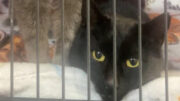By Doug Tallamy
Across the nation, homeowners, landscape designers, and land managers are recognizing the critical role our managed landscapes now play in sustaining the plants and animals that run our ecosystems. Traditional landscaping practices that have been pursued for generations have not left enough natural areas to do the job. We must change our approach to landscaping in order to provide what nature needs in our gardens and yards. And what nature needs most right now are diverse and complex food webs.
Insects are an essential component of complex food webs because so many other animals eat them. All amphibians, many reptiles and mammals, and nearly all birds get much or all of their protein by eating insects. If insects were to disappear, our nation’s food webs and all the animals they support would vanish as well. We humans cannot tolerate the disappearance of other species because it is precisely these species that run our ecosystems. We must pay attention to what our insects need. Keeping insects happy when it’s warm is easy. All we need to do is supply the herbivorous insects with the plants that they eat: Native plants. Plants from Asia or Europe are typically toxic to our local insect herbivores, but these same insects are well equipped to avoid the toxic defenses employed by local native plants. If we have large and diverse communities of insect herbivores, we will have large and diverse communities of the insect predators and the parasitoids that eat them.
But how can we pamper our insect communities during the cold months of fall and winter? Insects keep a low profile in the “off” season – so low, in fact, that they seem to disappear altogether. Some do fly south, just like migrating birds. The monarch and several dragonfly species are among our best-known insect migrants. But most attempt to spend the winter right in our yards. They can survive freezing temperatures either as eggs, larvae, pupae, or adults because insects produce an antifreeze (glycerol), in their bodies. The glycerol keeps the water in their tissue cells from freezing, expanding, and tearing the cell walls. Unfortunately, the biggest threat to over-wintering insects doesn’t come from the weather. It comes from us, as we strive to “clean up” our flowerbeds, lawns, and meadows. A little knowledge about how insects spend the winter can help us avoid killing them unintentionally.
Grasshoppers have chosen an overwintering strategy that enables them to escape even our most diligent fall cleanups. That may explain why they are often one of our most numerous insect groups. After they mature in mid to late summer, grasshopper females telescope their abdomens deep into cracks in the soil. Once they penetrate at least an inch of soil, they lay a clutch of eggs. The eggs stay underground, out of harm’s way, until late the following spring. They then hatch into tiny grasshoppers: Miniature replicas of their parents, lacking only size, wings, and sexual maturity. Crickets also bury their eggs in soil using a long needle-like ovipositor to inject eggs underground.
Various katydid species live in both meadows and forests. Females of forest-dwelling katydids typically have broad, spatula-shaped ovipositors that they use to glue rows of huge oval eggs to the twigs of their favorite plants. Careful inspection of Viburnum and dogwood twigs any time between September and May often reveals katydid eggs in their unobtrusive splendor. In contrast, meadow katydid females have sharp, sword-shaped ovipositors capable of piercing the stems of horseweed, goldenrods, or asters. It is within such stems that meadow katydids bury their eggs for safe-keeping during the winter months. In fact, many insects common in old fields, such as plant bugs (Miridae), leafhoppers (Cicadellidae), and stilt bugs (Berytidae) insert their eggs into the stems of meadow forbs and grasses. When we mow our meadows to get rid of those unsightly dead stems of last summer’s plants, we pulverize the next generation of the very insects we hope to cultivate to feed other creatures.
Many other insects spend the winter hiding as adults in leaf litter or thick meadow thatch. The sycamore, cherry, hawthorn, and goldenrod lace bugs, for example, produce several generations each summer, but the last generation flies to the ground and crawls beneath the damp leaf litter for the winter. Insects such as these are able to withstand extremely cold temperatures as long as they can find a safe site that is high in humidity. Cold-and-dry is a deadly combination for most insects. Since few natural substrates are better at holding moisture, thick leaf litter is ideal for overwintering. This is just one more reason to retain, on your property, as many of your fallen leaves as you can.
Many insects protect their eggs from both predators and severe weather by embedding them in protective coatings. Enchenopa binotata is a species of treehopper that covers its eggs in a frothy white coating of waxy material. Often many females, together, lay their eggs along a twig of their host plant, giving the appearance of decorative blobs of icing. Look for Enchenopa eggs on woody plants such as blackhaw viburnum, black locust, or black walnut.
After eclosing as adults from their cocoons in June, tent caterpillar females mate and immediately encase all their eggs within a coating that looks for all the world like brown Styrofoam. These egg masses encircle thin twigs of the caterpillars’ favorite host plants, primarily black cherry and apple. They remain in place for the rest of the summer, the fall, and the entire winter, hatching precisely when the leaves begin to break bud in early spring. These hatchlings are the larvae we see in the bothersome bag-like, gauzy structures, hanging in trees.
Another group of insects that protects its eggs within a Styrofoam-like case is the praying mantid. The shape of the egg case depends on the species of mantid. Chinese mantids, common in the Northeast, lay egg cases in late summer and early fall, that are somewhat barrel-shaped. These are often glued to dead stalks of vegetation in meadows. Carolina mantids are more common south of New Jersey; they affix elongate, rather flat egg cases to vertical substrates such tree trunks or your back porch.
Although monarch butterflies avoid cold weather by flying from North America to a few high valleys in the Sierra Chincua mountains of Mexico, most butterfly species spend the winter as chrysalids suspended from dead sticks and stems in your meadow or butterfly garden. Swallowtail species, such as the tiger, zebra, and spicebush swallowtails, hook the base of their chrysalids into a small silken pad spun to a vertical structure, and then lean back against a silk girdle that is also fixed to the structure and encircles the chrysalis around the wing pads. They spend the fall and winter in this precarious position until the first warm days of spring when they eclose to adults.
Most members of the family Nymphalidae, such as American painted ladies, commas, and question marks, hang their chrysalids upside down from a horizontal stem. The red admiral, in contrast, spends the winter as a first-instar larva within a hibernaculum, a tiny leaf rolled with silk at the terminal of a black cherry branch. With a little practice you can learn to recognize these hibernacula (winter residences), which are often on young cherry seedlings in your flowerbeds. These, of course, are the same “weeds” that many homeowners pull out of their butterfly gardens during fall cleanup, much like throwing the baby out with the bath water.
Like red admirals, fritillary species that develop on violets, such as the great spangled and regal fritillaries, have adjusted their over-wintering strategy to match the ephemeral nature of their host plants. Violets grow quickly in the early spring, bloom, and then decline by early summer. But fritillaries are ready for the sudden abundance of their food in spring because they spend the winter as first-instar larvae in the duff near their violet hosts. When you mow that patch of violets that has sprung up in your lawn in May, you are not only eliminating the food for local fritillaries, you are grinding up all the young fritillary larvae that have just beaten the odds of making it through the long winter.
A few butterfly species, most notably the mourning cloak, spend the winter as adults. In the last warm days of the fall, mourning cloaks locate a hollow log or tree trunk and simply cling to the edge of their shelter for the entire winter. At the first signs of spring they leave their hiding places to bask in sunny areas on the forest floor. Mourning cloaks are thus the first butterflies we typically see in the spring.
Unlike butterflies, most moths spend the winter as pupae in underground chambers (sphinx moths, royal walnut moths, many moths of family Noctuidae) or as pupae within elaborately spun cocoons. Our most spectacular moths, the giant silk moths, may spin their large cocoons directly to the trunks of their host plants, like the cecropia moths; hang their cocoons from strong silken strands from twigs, like the promethean moths; or spin their cocoons within folded leaves that fall from the host tree in October. This last strategy is common among polyphemus moths and luna moths. This puts these beautiful creatures at risk of being raked up and mashed into trash bags by homeowners eager to rid their lawns of leaves.
Many insects spend the winter as weather-resistant eggs, fully exposed to the elements. Reduviid assassin bugs, like the cogwheel bug, lay large clutches of eggs about head high on the bark of trees. These are black, and hard to find until they hatch in the spring. Young cogwheel bugs have bright red abdomens, and hatchlings stand out while they huddle near their egg mass for a day or two after hatching. During this time the hatchlings suck fluids loaded with symbiotic microorganisms from the bottom of their egg shells. These symbionts help the bugs digest meals the rest of their lives.
You can see that a great many of the insects that we enjoy in our landscapes or that make our gardens valuable contributors to local food webs spend the winter in the dead plant parts that we are used to removing in the fall. The easiest way to preserve overwintering insect populations is to relax our neatnik standards whenever possible. Plant the herbaceous perennials that spend the winter as dead stalks in less public areas of your properties. Come to realize that these stalks are not quite as dead as they seem, and are the normal condition of these plants in nature, a condition that many insects take advantage of during the fall and winter. It is true that meadows must be mowed or burned occasionally or they won’t stay meadows very long. I recommend mowing in early March, after the birds have eaten most of the seeds from your goldenrod, black-eyed Susans, echinacea, and pasture thistle. And rather than mowing your entire meadow, mow one-quarter to one-third of it each year: the smaller the meadow the smaller the area to burn or mow each year. In that way, a portion of your meadow will be left intact each year, and will serve as a refuge and a source of insects to recolonize the part that you do mow. Each part of your meadow, then, will be mowed (or burned) once every three to four years, just often enough to keep invading woody plants at bay.
Dr. Douglas Tallamy is Professor and Chair of Entomology and Wildlife Ecology at the University of Delaware.
Wild Ones Natural Landscapers, P.O. Box 1274, Appleton, Wisconsin
Reprinted from the Wild Ones Journal, Vol 23 #5, 2010.
This educational blog is a series of informative articles from the Penn State Master Gardeners volunteers plus news concerning the group and their activities. For more information, click here.



































